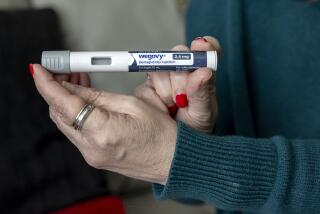Preventing breast cancer just got easier. Will more women give these drugs a try?
Breast cancer will strike 1 in 8 women in her lifetime. But women who face an increased risk of being that one unlucky patient may improve their chances with three prescription medications, according to a new report.
If 1,000 women took one of the three medications for roughly five years, somewhere between seven and 18 breast cancers could be prevented, and possibly more. But each of the drugs — two originally used to treat breast cancer and a third that prevents the bone-thinning disease osteoporosis — comes with the possibility of serious side effects, including blood clots and a higher likelihood of uterine or endometrial cancer.
That mixed picture prompted a panel of preventive healthcare experts to suggest that doctors routinely discuss these medications with women who have an elevated risk of breast cancer.
For women at average risk of breast cancer, the harms of the drugs clearly outweigh their benefits, the panel said.
The draft recommendation was released Tuesday by the U.S. Preventive Services Task Force, which will accept public comments on the proposal until Feb. 11.
The new recommendations expand the medication toolkit that can be used to ward off breast cancer. For the first time, the task force added a class of drugs called aromatase inhibitors to the cancer-prevention lineup. These drugs include anastrozole (known commercially as Arimidex), exemestane (Aromasin) and letrozole (Femara).
For post-menopausal women, a five-year course of aromatase inhibitors appears to offer more potent breast cancer prevention than the two drugs long known to have such effects — tamoxifen (sold as Nolvadex and Soltamox) and raloxifene (Evista). In studies, women taking aromatase inhibitors were more likely to experience hot flashes and pain in their bones and muscles compared with women taking a dummy pill. But preliminary signs showed no significant increase in the risk of blood clots.
“It’s always great to have more choices,” said UCLA internal medicine specialist Dr. Carol M. Mangione, who chaired the panel’s deliberations on breast cancer prevention drugs.
Breast cancer is the most common non-skin cancer and the second-leading cause of cancer death in women. In 2018, some 30% of new cancer cases in women were breast cancers, representing 266,120 patients. When a newfound malignancy is confined to the breast, at least 90% of women go on to live for at least five years. If it has spread to distant organs, the prognosis can be far bleaker.
The new recommendations highlight an enduring mystery: Why don’t more women whose mothers or sisters have been diagnosed with breast cancer, or who have a personal history of abnormal findings on mammograms, take these drugs? There’s clear evidence that they can prevent breast cancer, a disease justifiably feared by women. But very few women utilize them to prevent a first occurrence of cancer.
No more than three out of 10 primary care doctors have ever prescribed these drugs for breast cancer prevention, studies suggest. And just 16% of women who could benefit from them are thought to be using them. Even women who are well informed about the drugs’ benefits and risks apparently focus more heavily in their downsides and show little interest in taking them, the panel said.
For women who are healthy and who have generally passed through the discomforts of menopause, the side effects can be unpleasant and even dangerous, to be sure. Women taking tamoxifen and raloxifene had higher rates of blood clots, endometrial cancer, cataracts and hot flashes. Bone and muscle pain and hot flashes are common side effects of aromatase inhibitors, and they may slightly increase a woman’s risk for heart attack or stroke, though the evidence for this is conflicting.
But for women whose odds of developing breast cancer within five years are elevated, the preventive benefits of these drugs have probably been underestimated, Mangione said. That’s because most of the women who participated in studies to test the medications were at average risk for breast cancer. If the drugs were to be tested only on women at higher risk, there’s reason to believe their effectiveness would be more pronounced, she said.
One more benefit of tamoxifen and raloxifene: Both were found to reduce a woman’s risk of vertebral fractures.
“For anybody who is healthy and taking care of themselves, it gives you pause to think about taking a medication for five years,” Mangione said. “The important thing is to understand your own risk profile and to understand the possible harms and benefits, and have that conversation. It’s still a personal choice whether you take one of these medications.”
In the five years since the task force first declared tamoxifen and raloxifene worth considering as breast cancer preventives, neither doctors nor patients appear to have gotten the message, Mangione said.
“One of the goals of this new recommendation, and with the inclusion of another class of drugs, is the hope this will raise awareness that this is something worth talking to your physician about,” she said. That’s especially true for older women with a mother or sister who’s had breast cancer, for women 45 or older whose mother or sister had cancer in both breasts, and for women who were diagnosed before age 50, she added.
In drafting its recommendations, the task force acknowledged that there are special populations of women for whom the mix of potential harms and benefits are less well understood. For women who bear a high-risk variant of the BRCA 1 or BRCA 2 gene, the prevention benefits of these drugs are not clear. That’s also true for African American women, who are diagnosed with breast cancer at rates similar to white women but are more likely to die of the disease.
What is clear is that these drugs drive down rates of estrogen-receptor-positive breast cancer, and not the rarer ER-negative form of the disease. Tamoxifen and raloxifene do so by blocking the proliferation of estrogen-sensitive epithelial cells, where breast cancer can develop. Aromatase inhibitors decrease the amount of estrogen available to bind to those epithelial cells, in part by impeding the conversion of androgen to estrogen.
Tamoxifen and raloxifene can be used to treat both premenopausal and postmenopausal women. They have both been approved by the Food and Drug Administration for breast cancer reduction, and are both available as generic medications.
The aromatase inhibitors should be used only in post-menopausal women, and are sold in generic forms. But the FDA has not assessed or approved the marketing of these drugs for breast cancer prevention. The drug safety agency is unlikely to be asked to do so, since no pharmaceutical company would substantially profit from a medication now available as a generic drug.
MORE IN SCIENCE






